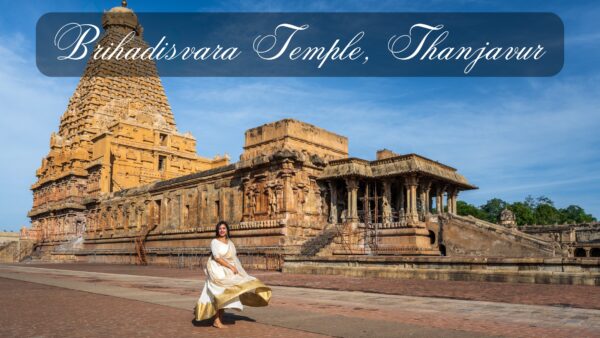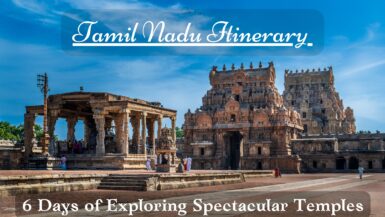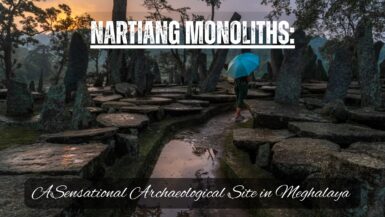A trip to Tamil Nadu surely remains incomplete without paying a visit to the stunning Brihadisvara Temple. With its vimana literally touching the sky, this resplendent temple is regarded as an icon of the Tamil Dravida style of temple architecture. It was built by Rajaraja the Great and served as a symbol of the Chola imperial power. Since its inception, the Brihadisvara Temple has continued to awe pilgrims, art enthusiasts, and travellers alike.
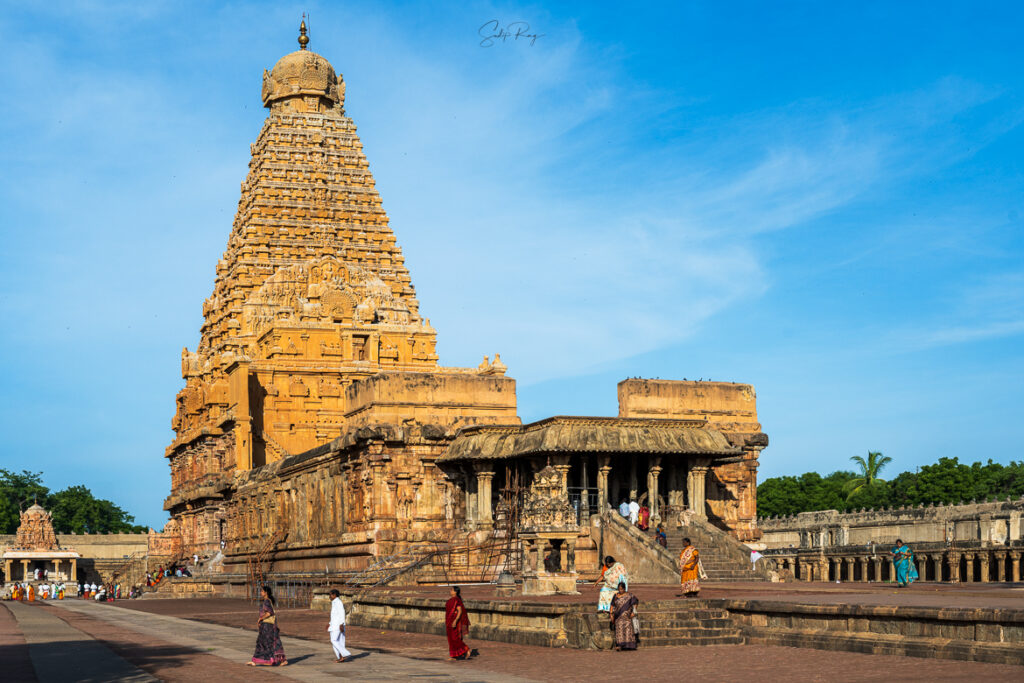
Table of Contents
Who was Rajaraja I Chola?
Rajaraja the Great was truly the ‘King of Kings’. Known as Rajakesari Arumolivarman (which literally means ‘blessed tongue’), Rajaraja was the greatest Chola emperor, and the long thirty years of his rule constituted the formative period of Chola imperialism.
After ascending the throne, Rajaraja had first assembled a marauding army, and his chariots of war flaunting the tiger pennants launched a victorious march across south India. His empire-building was extremely ambitious. A strategist par excellence, he decisively destroyed the alliance among the Pandyas, Cheras, and Ilam or Lanka. Following this, he undertook the title of Mummudi Chola or ‘Chola with Three Crowns’ as he flexed his domination over the three ancient Tamil kingdoms of Chola, Chera, and Pandya. Next, Rajaraja led his mammoth army towards Tungabhadra and annexed all the territory held by the Gangas and Nolambas in Mysore and Bellary. He also crushed the emerging Hoysala power. He defeated the Chalukyas of Vengi and reduced them to a vassal state. His last military feat was the conquest of ‘twelve thousand islands on seas’ or Maldives. Thus, the dashing emperor built the largest empire that the Tamil country had ever seen.
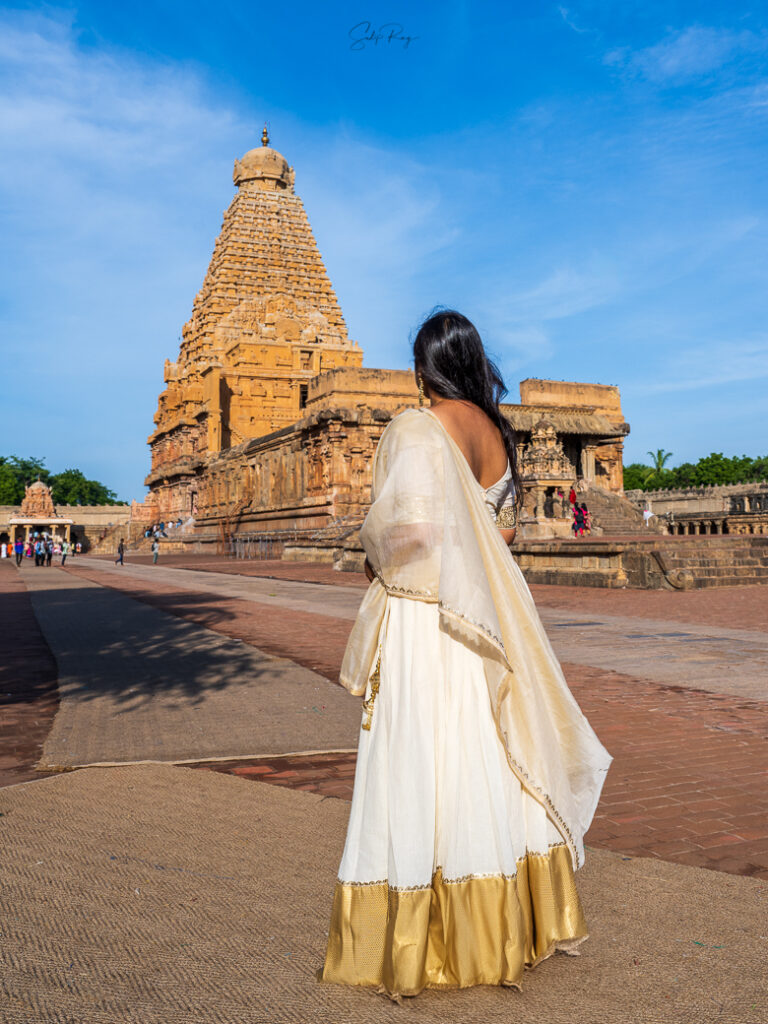
Interestingly, after building the first imperial empire of the south, Rajaraja sheathed his sword and concentrated on propagating peace and religion. Now, powerful productive forces were unleashed to take the newly built empire to new heights in art, architecture, religion, literature, administration, and statecraft. He revitalised architecture and commissioned the Brihadisvara Temple, which remains his magnum opus and a symbol of his imperial ambition. He patronized the iconic bronze artwork of Thanjavur and its surrounding region. It was also owing to his earnest endeavours that the hymns composed by the Nayanar saints were collected and compiled into ‘Tevaram’.
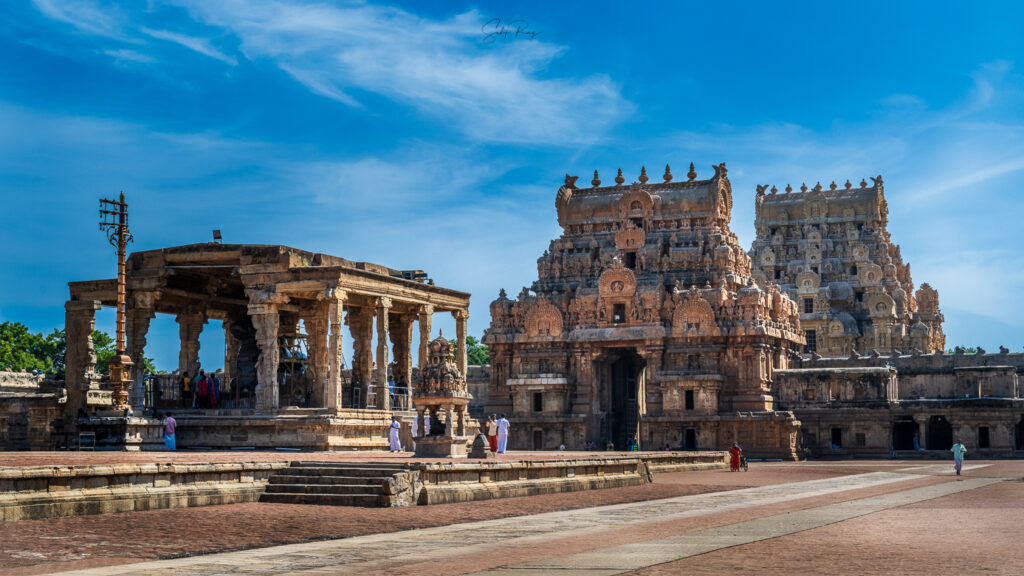
Rajaraja’s charity to the temple was legendary, as was the valour of his army. Both in warfare and in peacetime administration he had no equal. By the end of his rule, Rajaraja’s realm had evolved into an extensive and well-knit empire efficiently organised and administered, rich in resources, and possessed of a powerful standing army.
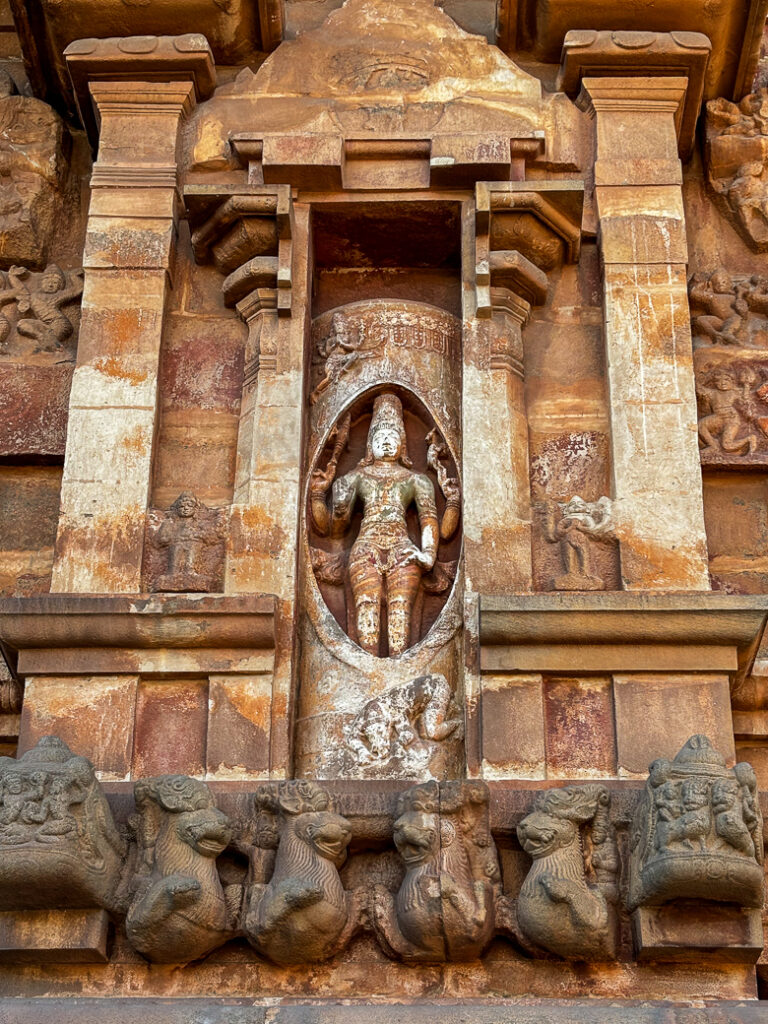
Why do you need to visit the Brihadisvara Temple?
The Brihadisvara Temple is regarded as the epitome of the Dravida style of temple architecture. It is also one of the largest Hindu temples in India. Built-in granite, it is a ‘Madakkoil’ type of temple, where a large temple is constructed upon a raised platform.
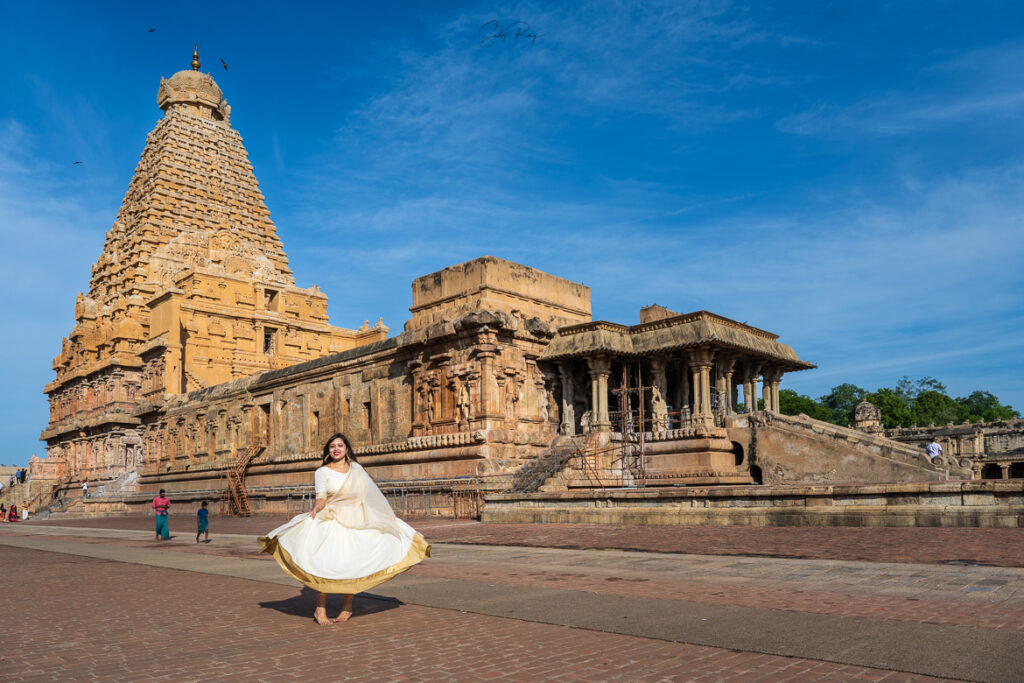
The Thanjavur temple was the most ambitious production of its kind hitherto undertaken by an Indian ruler. It was indeed a landmark in the evolution of temple architecture in southern India. Though the Chola architectural style borrowed ideas from the Chalukyan and Pallava temples, they towered above their predecessors in style, scale, and innovations. It surpassed all earlier temples in effort and size and invested the Chola crown with an immeasurable ritual dignity. It is indeed a remarkable manifestation of the engineering acumen of Chola builders.
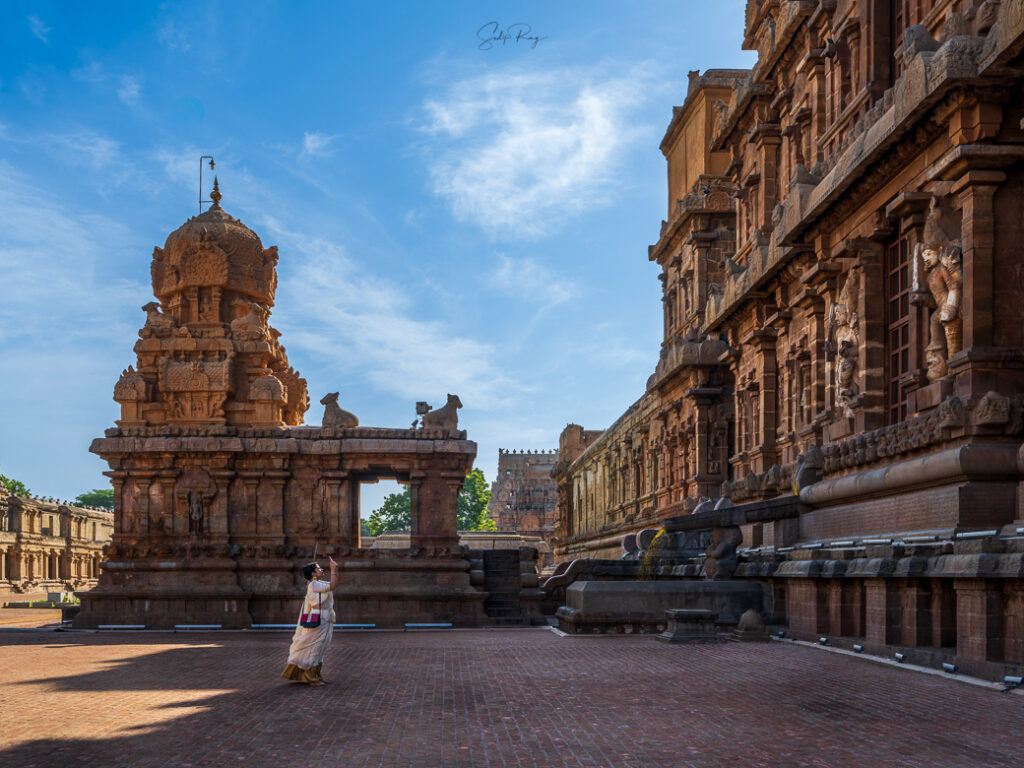
No wonder, UNESCO recognised the brilliance of the Brihadisvara Temple and listed it under the World Heritage Sites in 1987 along with the Brihadisvara Temple of Gangaikonda Cholapuram and Airavatesvara Temple of Darasasuram. The trio is called the Great Living Chola Temples.

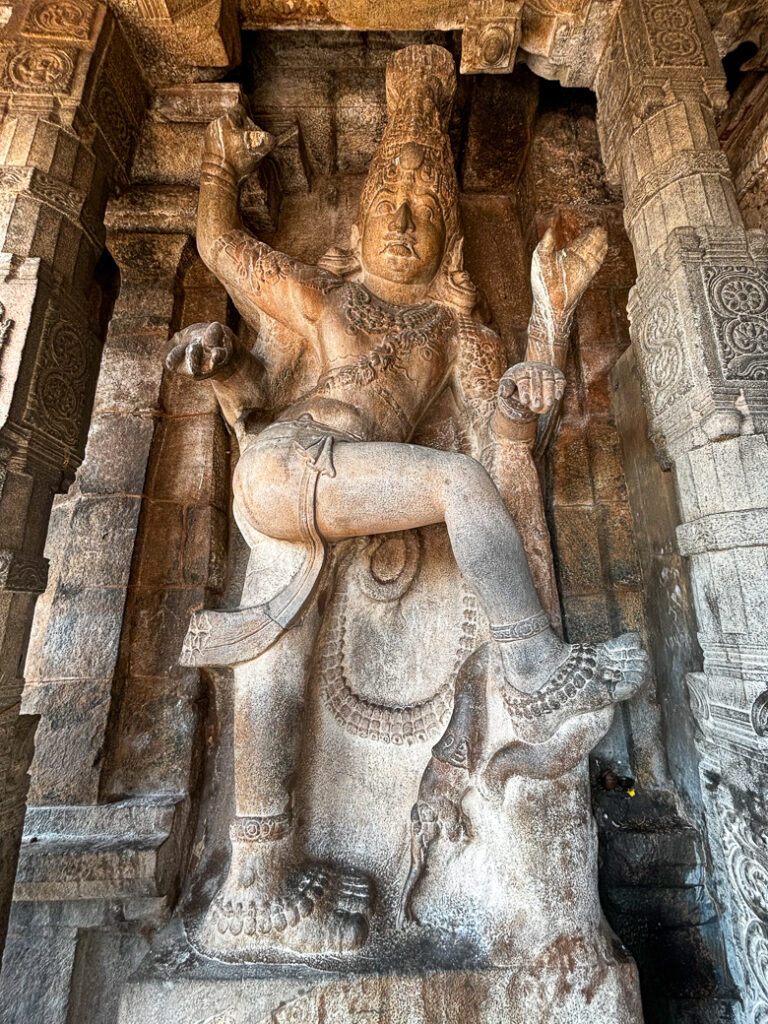
About Brihadisvara Temple:
The Brihadisvara Temple is also known as Rajarajesvaram (named after its illustrious author) and Thanjai Periya Kovil or Tanjore’s Big Temple. Dedicated to Siva, the construction began in 1003 CE and was completed in 1010 CE.
Built-in granite, Brihadisvara is a ‘Madakkoil’ type of temple, where a large temple is constructed upon a raised platform. The temple is entered through two gopurams, characterized by a plethora of excellent sculptures and barrel-vaulted roofs. As per the prevalent Hindu norms, it faces east. It is divided into five main sections – a Nandi mandapa, a mukha mandapa, a maha mandapa, a connecting antarala, and the ‘garbha griha’ or sanctum with the imposing vimana.
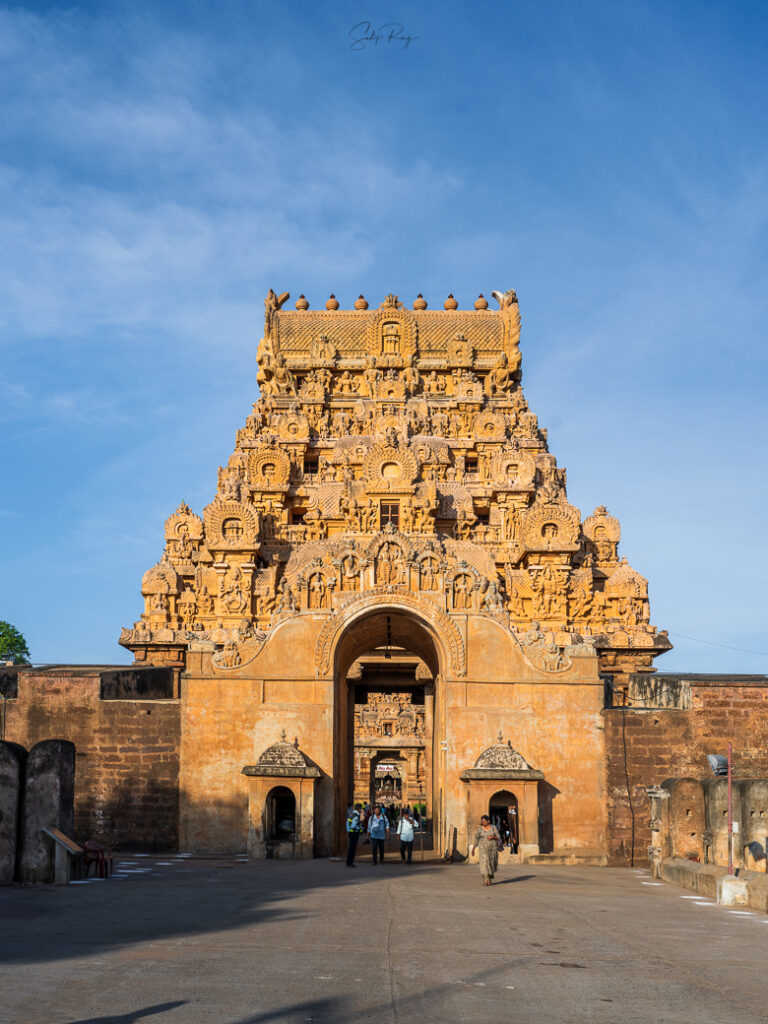
The temple was given a cosmic symbolism by calling it the ‘Dakshina Meru’ or Meru of the south (Meru being the mythical, sacred mountain serving as the centre of all universes). It was not only a centre of territorial authority of Rajaraja I, it was also symbolically the cosmic axis of the universe.
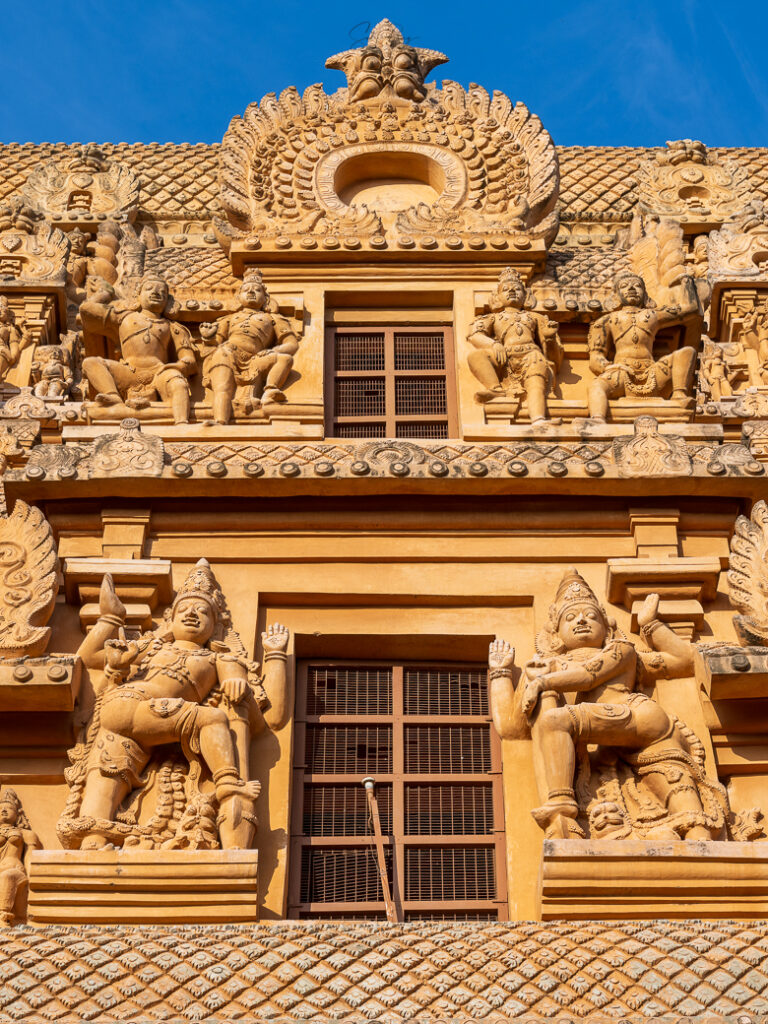
Thanjavur’s temple served as the political iconography of Rajaraja, representing the significant efforts at centralisation of power through various measures such as revenue surveys, redefining the ‘nadus’, encouraging the growth of ‘nagarams’, and setting up a systematic tax structure. Thanks to the series of stupendous military conquests of Rajaraja, the Brihadisvara Temple received revenues not only from the core Chola territory but also from the captured kingdoms.
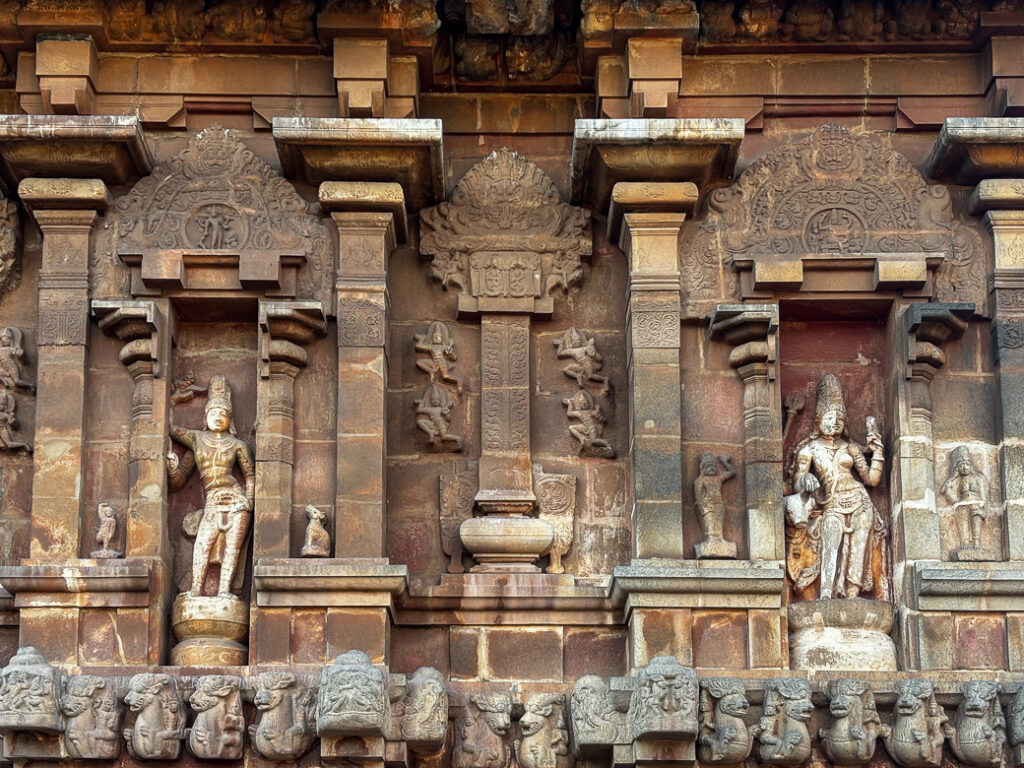
In its heyday, the temple had over 800 employees, including 400 temple dancers to entertain Siva and 50 musicians to regularly recite the ‘tevaram’ hymns composed by Tamil Saiva poet–saints. In addition, 175 celibate students mobilised from Brahmana villages served as assistants to the priests. Watchmen were employed to keep vigil, and their numbered nearly 150. Animal donations were also enormous, and Rajaraja himself gifted 2928 cows to this temple. These animals were again entrusted to 61 shepherds living in the vicinity of Tanjore. Across southern India and Sri Lanka, 369 settlements were connected with Thanjavur as endowments for the maintenance of Brihadisvara.
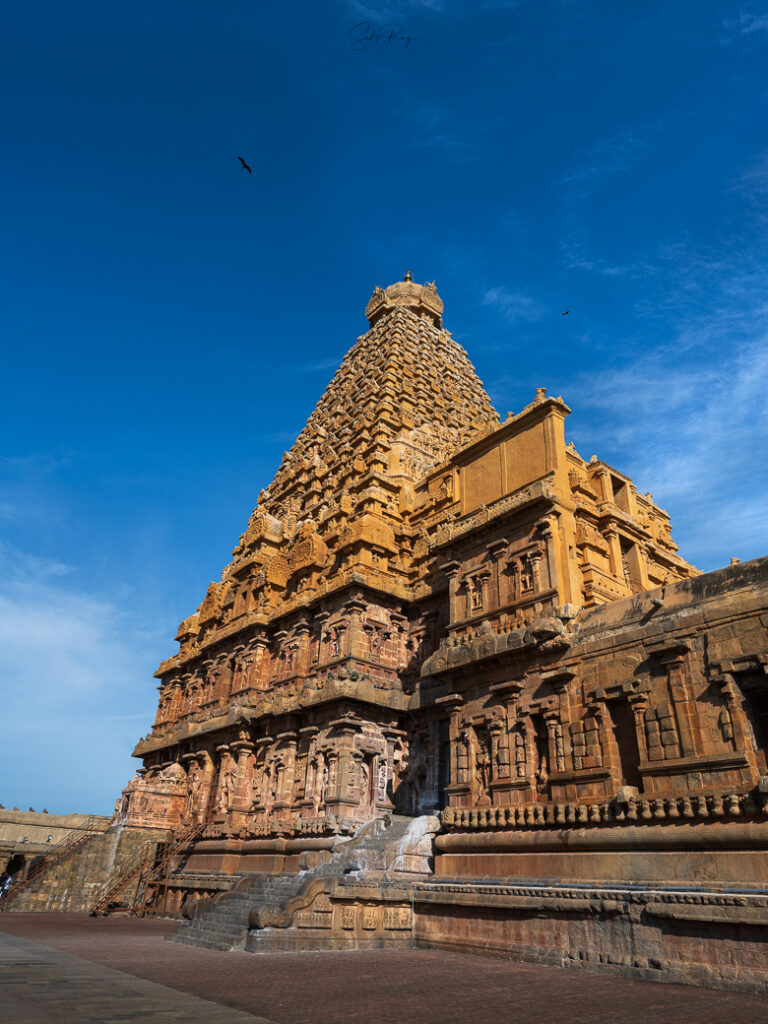
The ‘kovil’ was all rolled into one – the landholder, employer, and consumer of goods and services, while also filling in as a bank, school, museum, hospital, and theatre. Though loot and plunder accounted for its prosperity, it nevertheless served as a nucleus gathering around itself all that was best in art, music, poetry, and technology. The temple at the centre of the city was a cultural and artistic emporium.
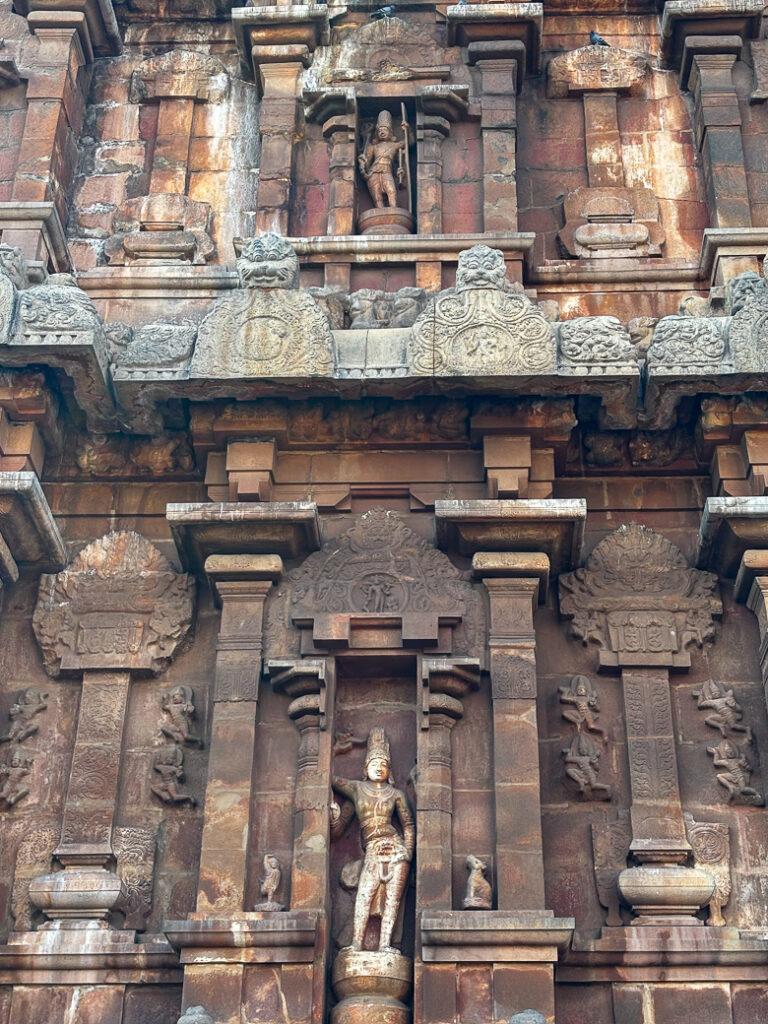
Moreover, the city of Thanjavur expanded around the Brihadisvara Temple at its core. Its lofty vimana and gopuras adorned the city’s skyline. The area around the temple was lined with mansions housing the city’s political and priestly elites. The next section was occupied by the rich merchants. Thanjavur boasted four huge markets, catering a variety of goods to different strata while having separate opening and closing hours.
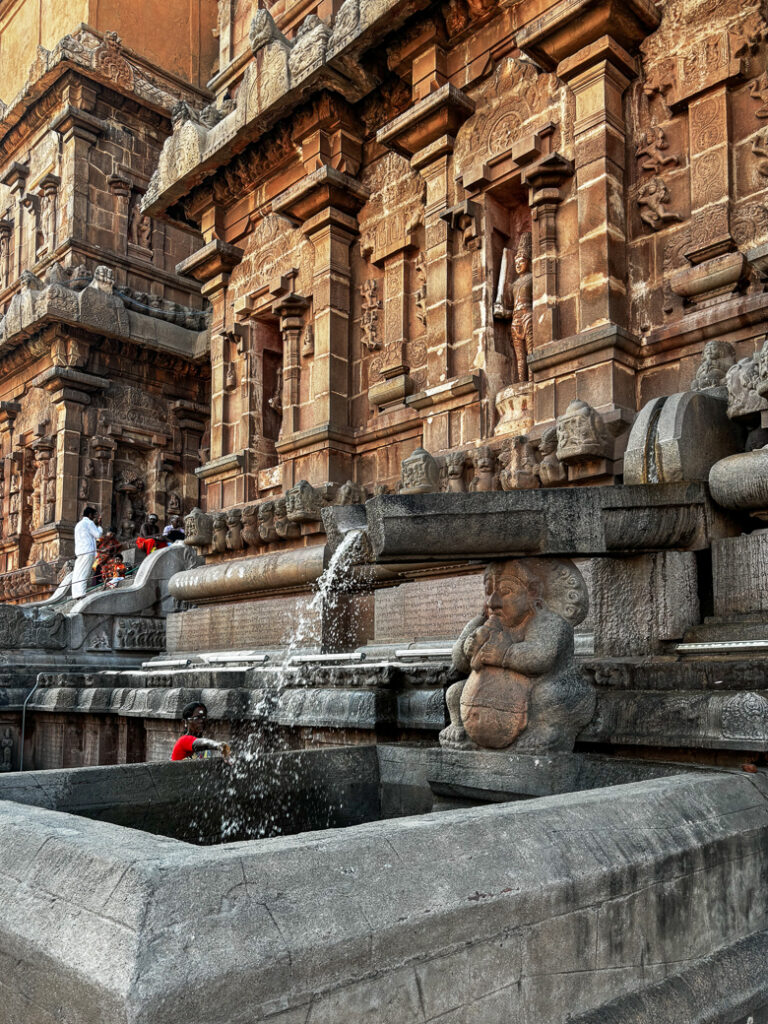
What to see inside the Brihadisvara Temple complex?
Gopuras:
Two stunning gopuras welcome visitors, who arrive for a Darsana. While the first gopura ascends up to five storeys, the second one is smaller and has three tiers. Both are characterized by barrel-vaulted roofs and a plethora of superb sculptures. The sculptures depict a pantheon of divinities such as various forms of Siva and his consort Parvati, Ganesa, Surya, Vishnu, and so on. The carvings also illustrate Saivite stories like the marriage of Siva – Parvati, Siva protecting Markandeya, and Arjuna winning the ‘Pasupata’ weapon.
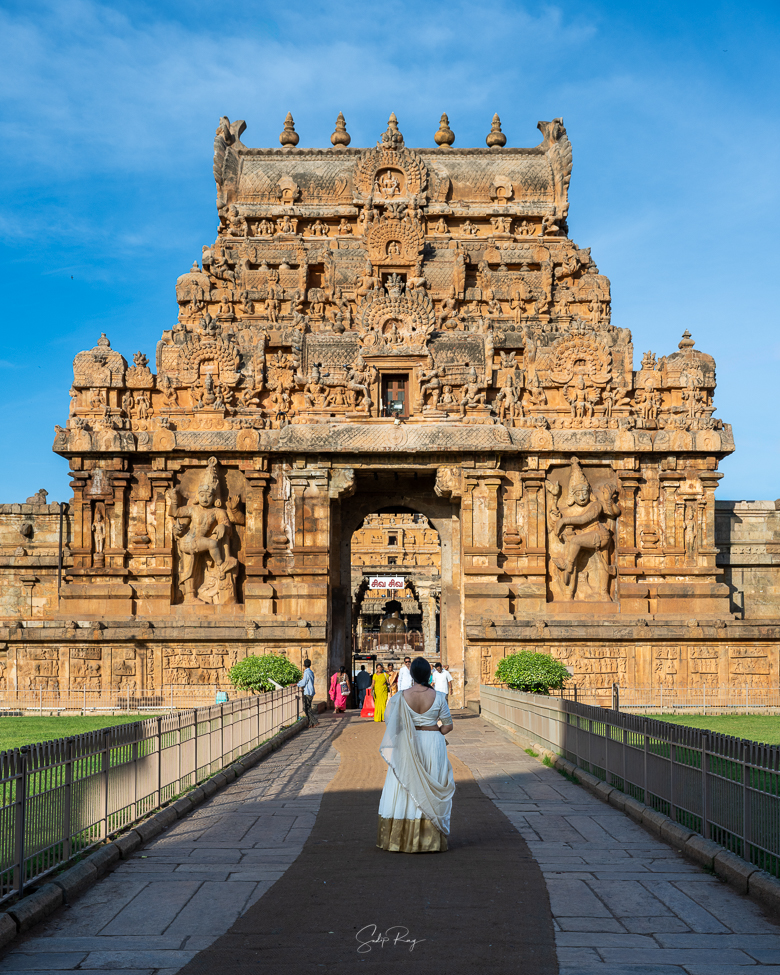
The smaller gopura is further flanked by two life-size and fierce dvarapalas. The dvarapalas are characterized by four arms, fangs protruding from their mouths, knitted eyebrows, rolling eyes, and hands in ‘tarjani’ or threatening and ‘vismaya’ or wonder mudras. This intimidating posture of ‘dvarapala’ is a standard found in every Chola temple, which differs greatly from the Pallava ‘dvarapala’ who appears quite natural.
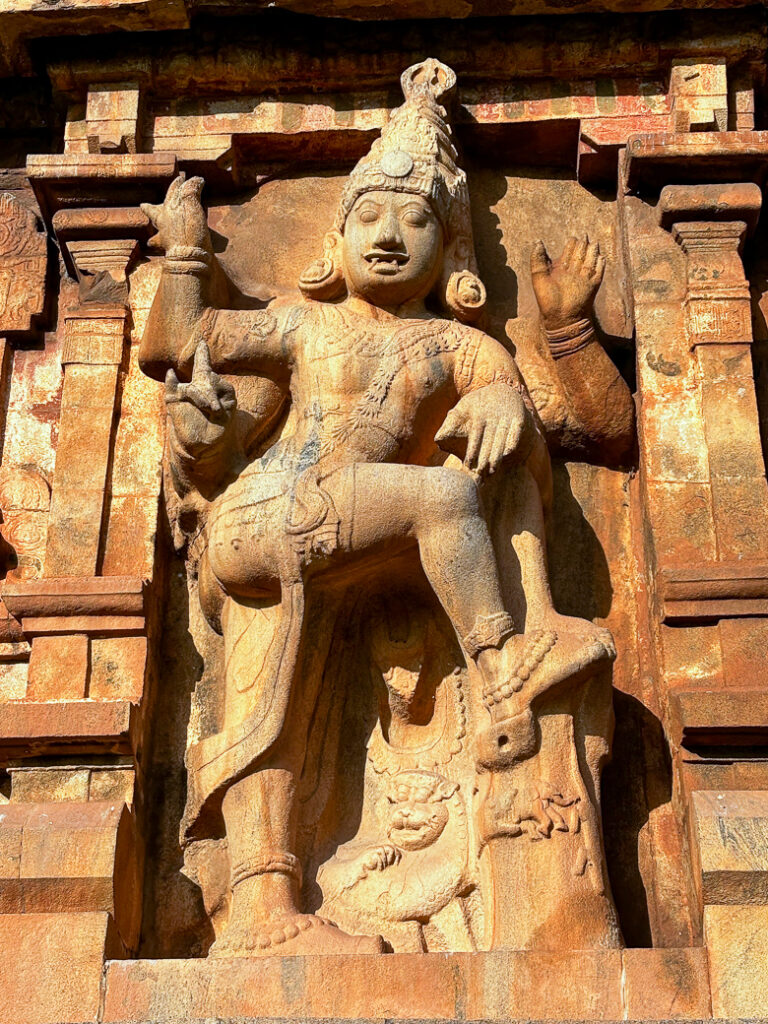
The gopuras are made of tiny ‘sala’ (rectangular), ‘kuta’ (square), and ‘panjara’ (apsidal) temples, and punctuated with elaborate lion-headed ‘kudu’ or arches.
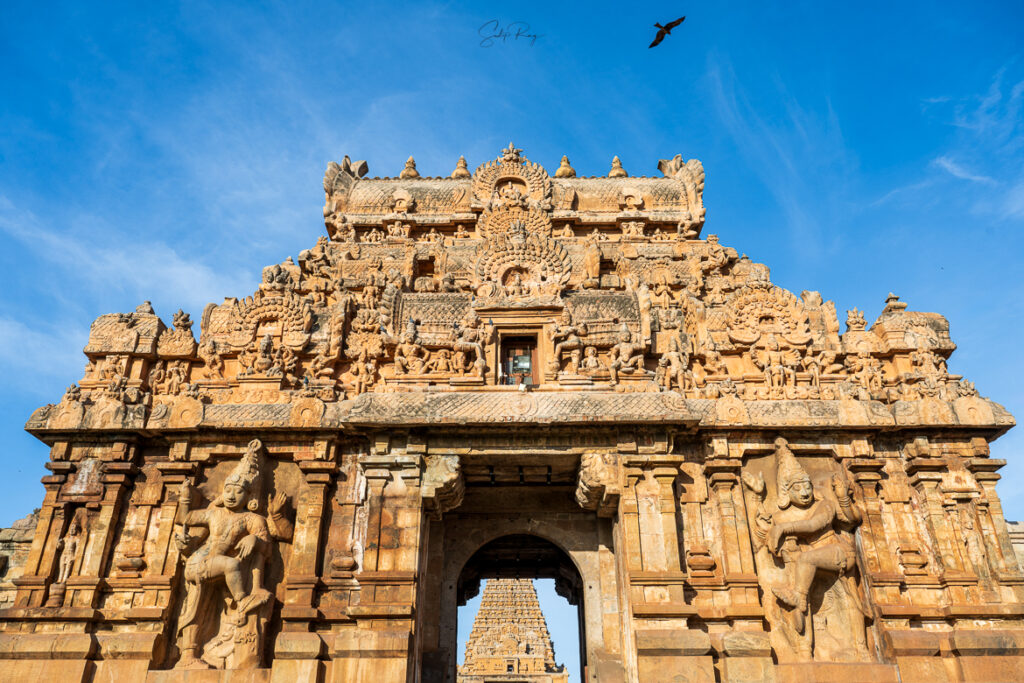
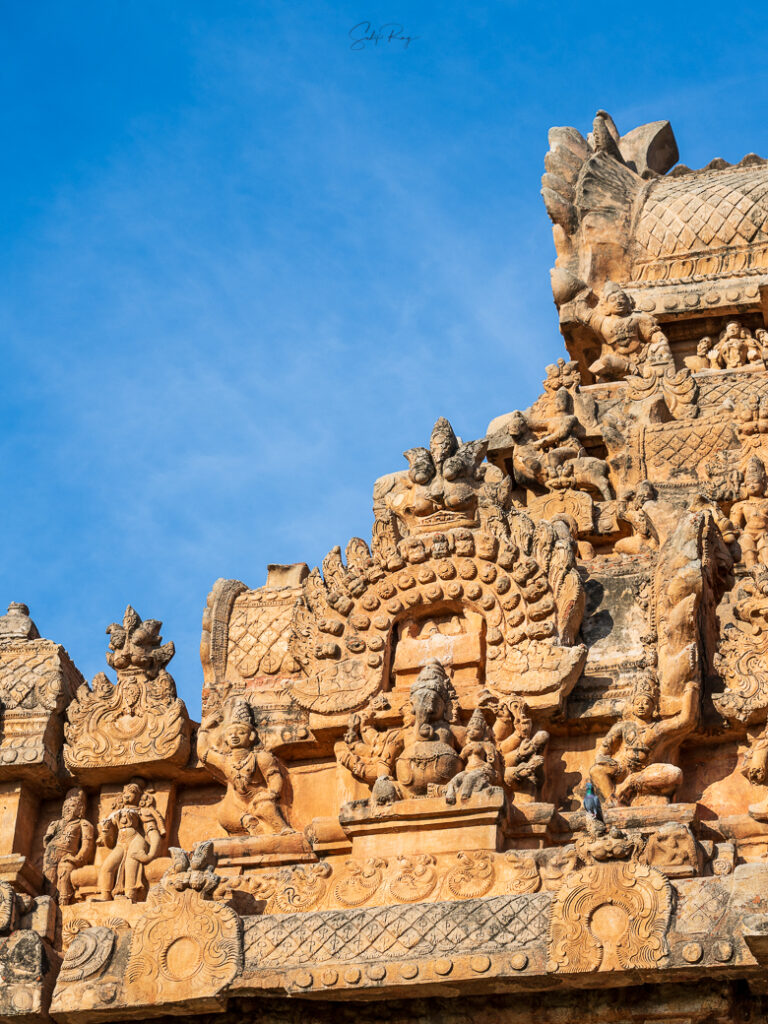
Nandi Pavillion:
A huge monolithic Nandi sits under a canopy of mandapa and faces the main shrine. The mandapa is a later addition, and its ceiling bears paintings from the Nayaka period.
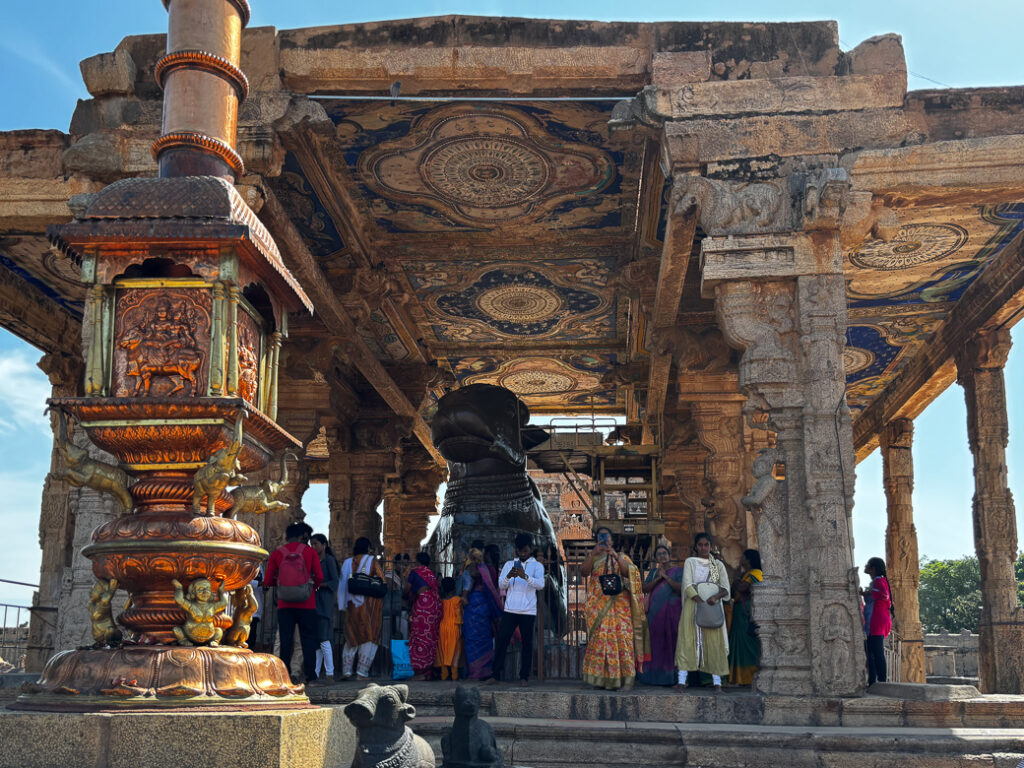
Sri Vimana:
The sky-kissing Sri Vimana of Brihadisvara Temple is truly a sight to behold. It soars high at 65 meters with 15 receding tiers and is decorated with miniature ‘sala’ (rectangular), ‘kuta’ (square), and ‘panjara’ (apsidal) temples. The superstructure perhaps served as a metaphor for the grandeur of the Chola Empire. The taller the temple tower, the more awe the emperor generated among friends and foes alike.
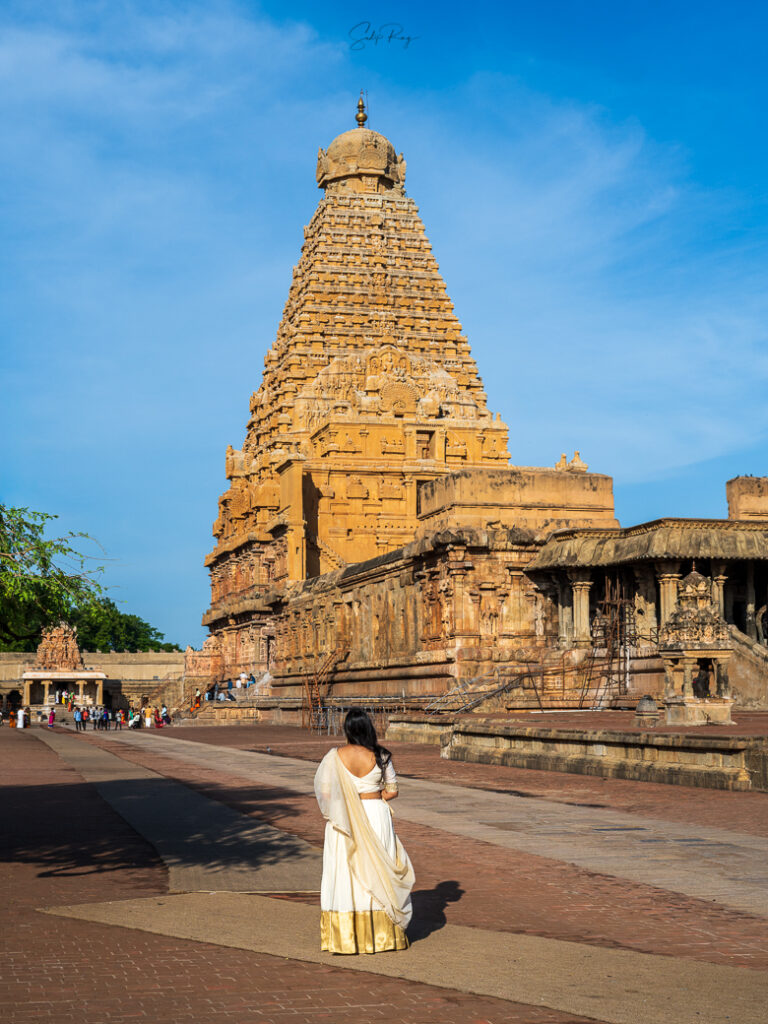
One of the most fascinating features of Brihadisvara is its gigantic ‘stupi’, which weighs around 80 tonnes. It is popularly believed to have been dragged up to its current position along an inclined plane that had its base at a place called ‘Sarapallam’, which lies 6.44 km away. The master designers built the hollow tower by interlocking stones without using any binding material.
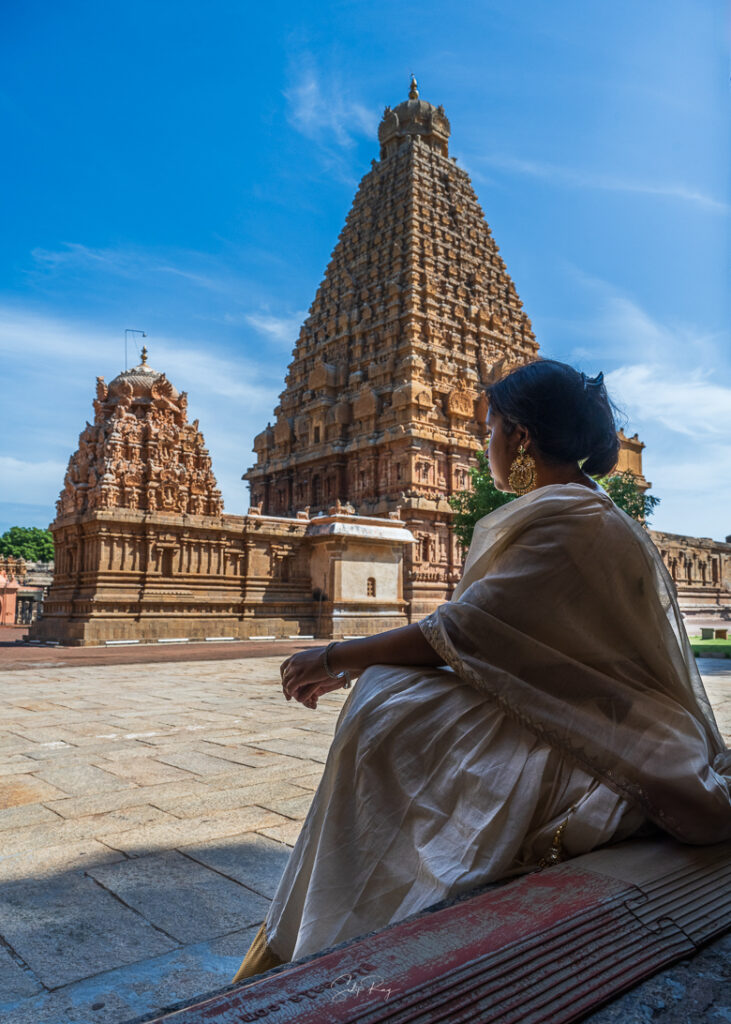
Sculptures on the outer walls:
The exterior of the temple is adorned with alternating ‘koshtha panjara’ or niches and decorative ‘kumbha panjaras’ or columnar niches with pot-like bases. The ‘koshtha panjara’ or niches are embellished with exquisite sculptures. Most of these carvings manifest Saivite themes, but a handful of them exhibit Vaishnavite themes. The Gods and demigods, engraved inside the niches, display ‘navarasa’ or human emotions with remarkable facial and bodily details. In fact, the Chola craftsmen gave shape to the ingenious iconography that the Nayanar saints had painted with their minds.
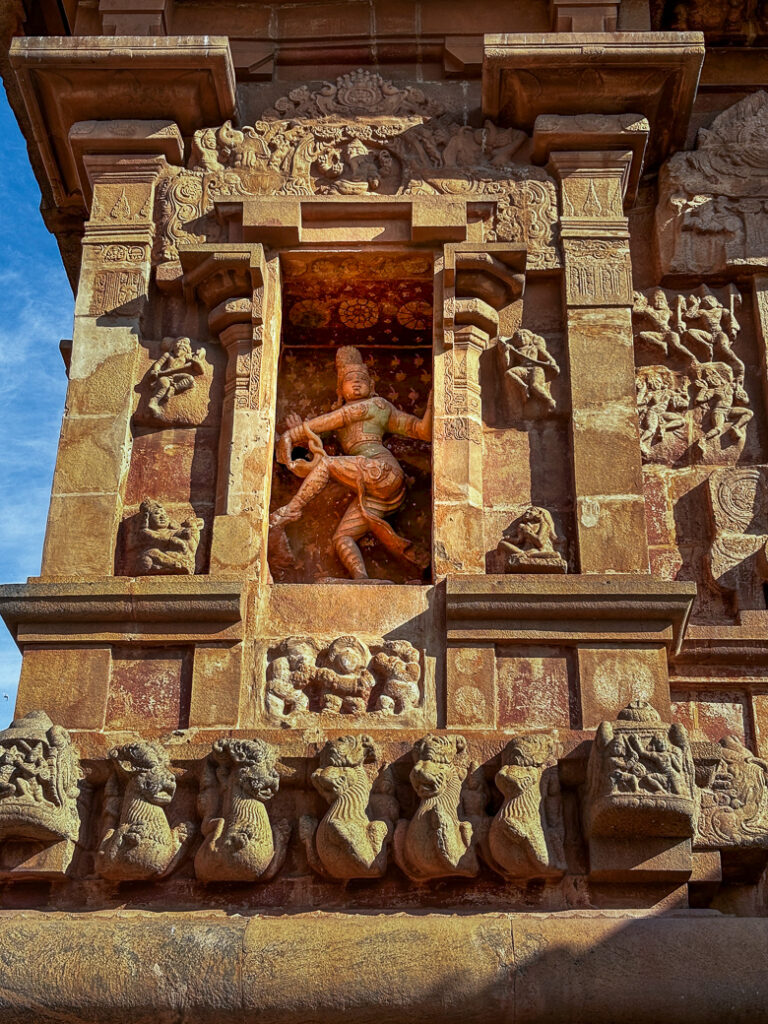
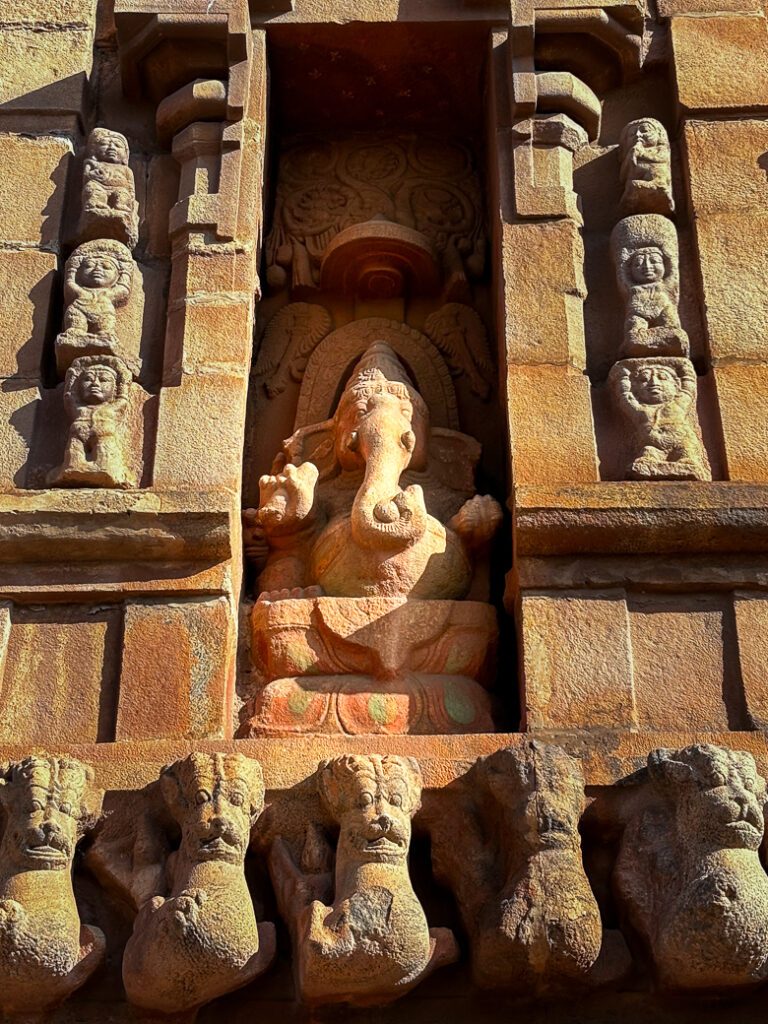
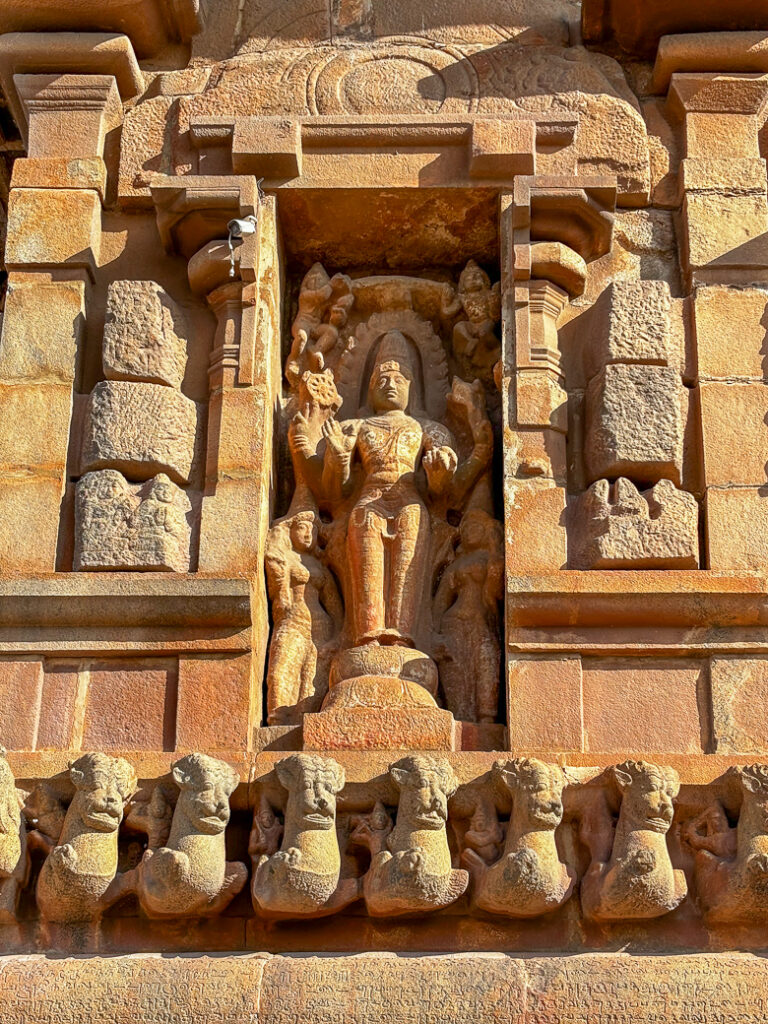
The sculptures are distributed along two layers. The lower niches depict Ganesha, Vishnu with Sri-Devi and Bhu-Devi, Lakshmi, Vishnuanugraha Murti, Bhikshtana, Virabhadra, Dakshina Murti, Kalantaka, and Natesa on the southern wall, Hari-Hara, Ardhanarisvara, Chandrasekhara on the west wall, Gangadhara, Sarasvati, Uma – Mahesvara, Mahisasuramardini, Chandrasekhara, Bhairava on the north wall.
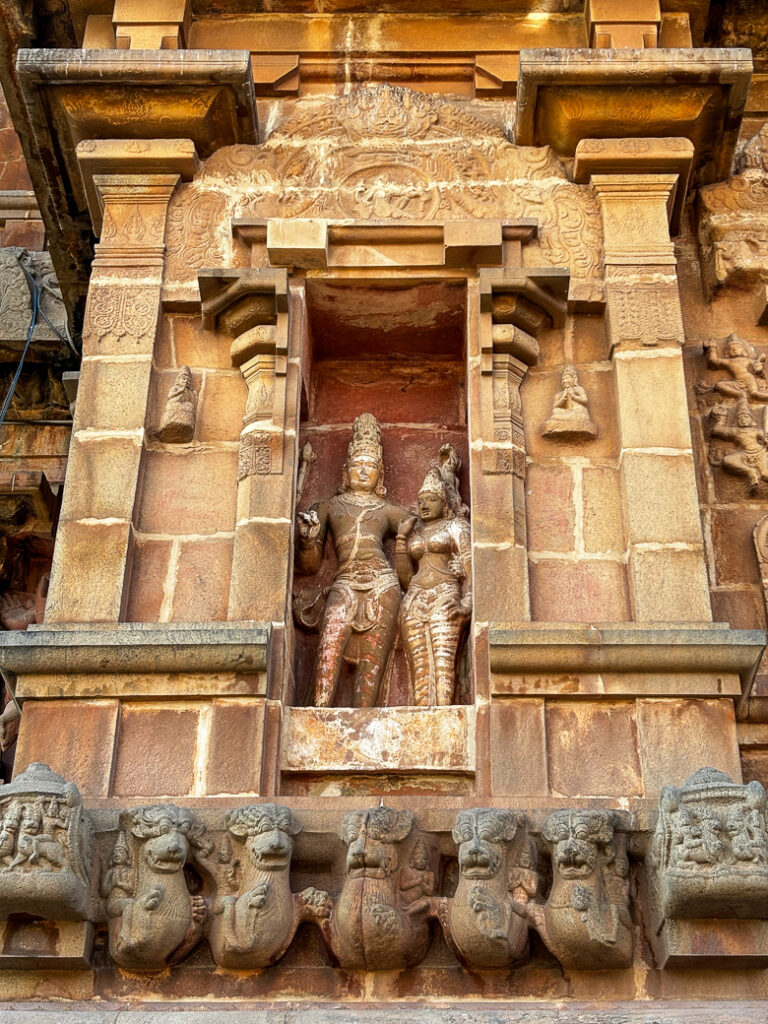
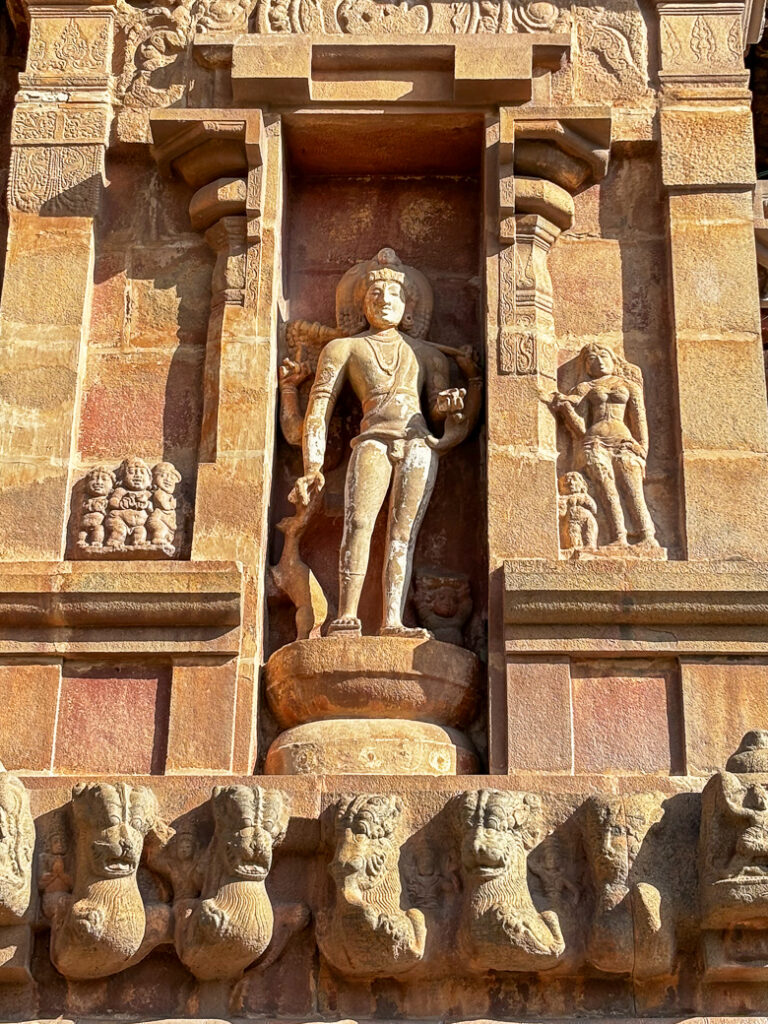
The upper niches on all walls contain Tripurantakas repeated in each niche. The Tripurantaka iconography somewhat represents the imperialist achievements of Rajaraja I himself. Just as Siva in his Tripurantaka form is the destroyer of three cities of the ‘asuras’, Rajaraja was the conqueror of three kingdoms of Pandyas, Cheras, and Eelam (Sri Lanka).
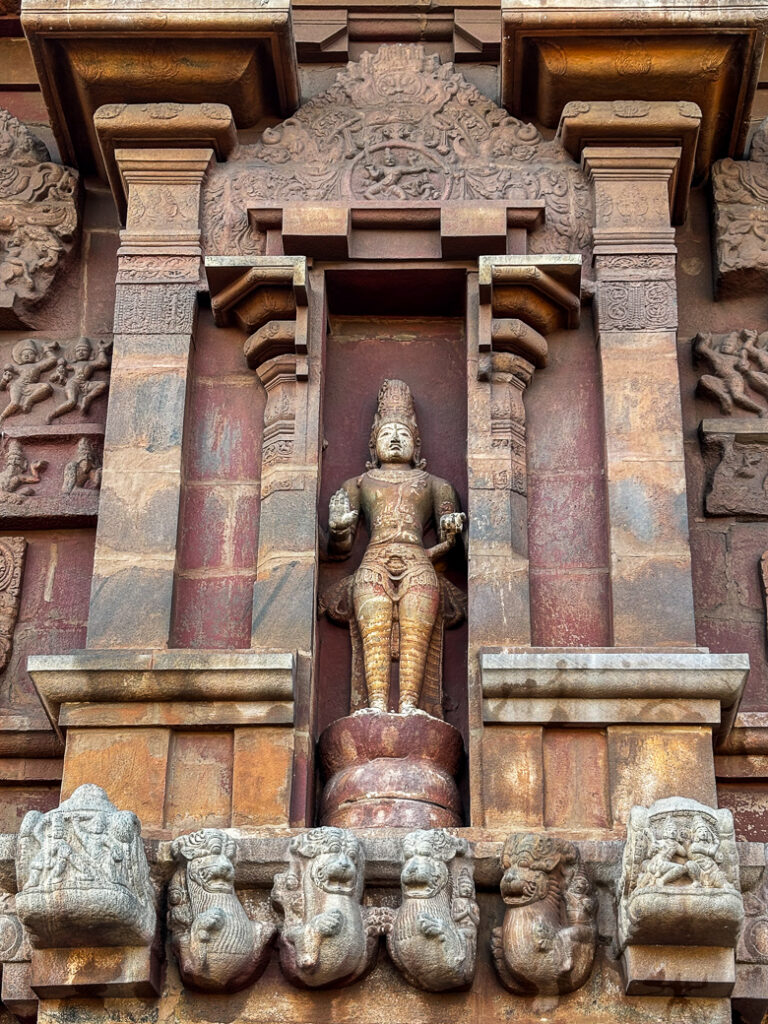
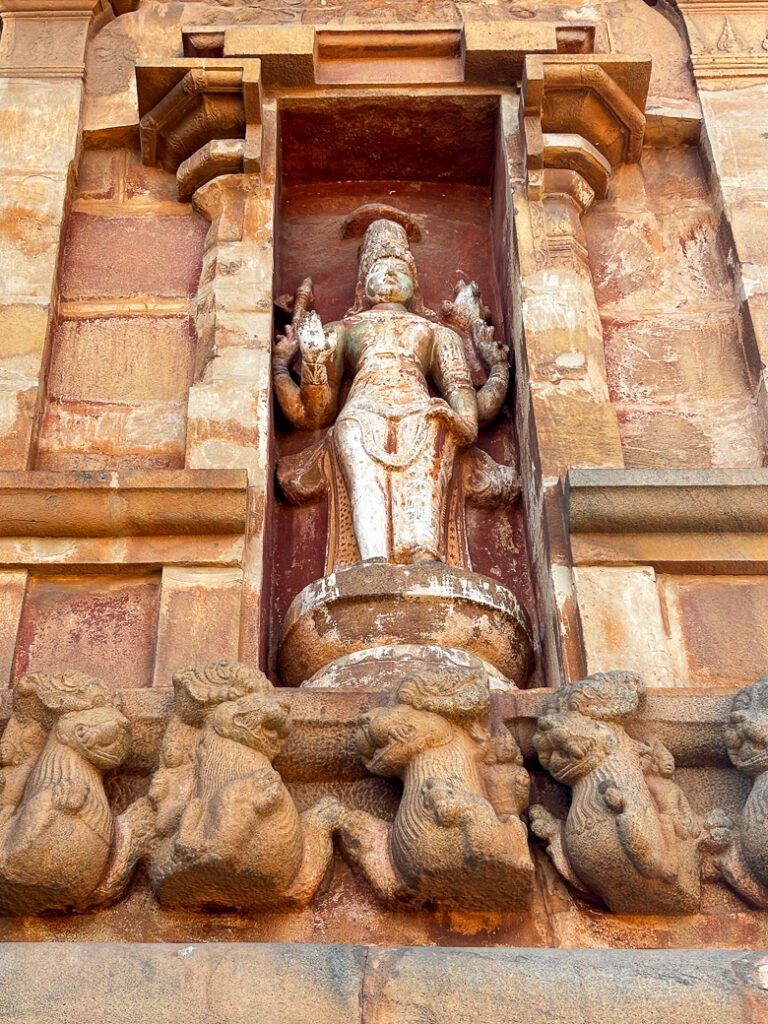
Inside the inner passageway of the sanctum, the walls showcase the unfinished series of 81 of the 108 ‘karana’ or dance poses from Bharata’s Natya Shastra. Interestingly, here Siva himself, as the Nataraja or lord of dance, is depicted as the dancer.
The Sanctum:
The innermost sanctum houses a linga, which is named Rajarajesvaram – Udayar after Rajaraja I, its author. It is also called ‘adavallan’ or ‘One who can Dance Well’ and ‘Dakshina Meru Vitankan’. Both of these names are generally associated with the Siva linga of Nataraja Temple of Chidambaram, whom the Cholas greatly revered, and thus adopted by them for the linga of Brihadisvara. The enormous linga is 8.7 metres high and receives worship four times a day.
Inscriptions:
The massive platform is fully covered with inscriptions in elegant Chola Grantha and Tamil letters. Of these, 64 inscriptions belong to Rajaraja I, and 29 to his son and successor Rajendra I.
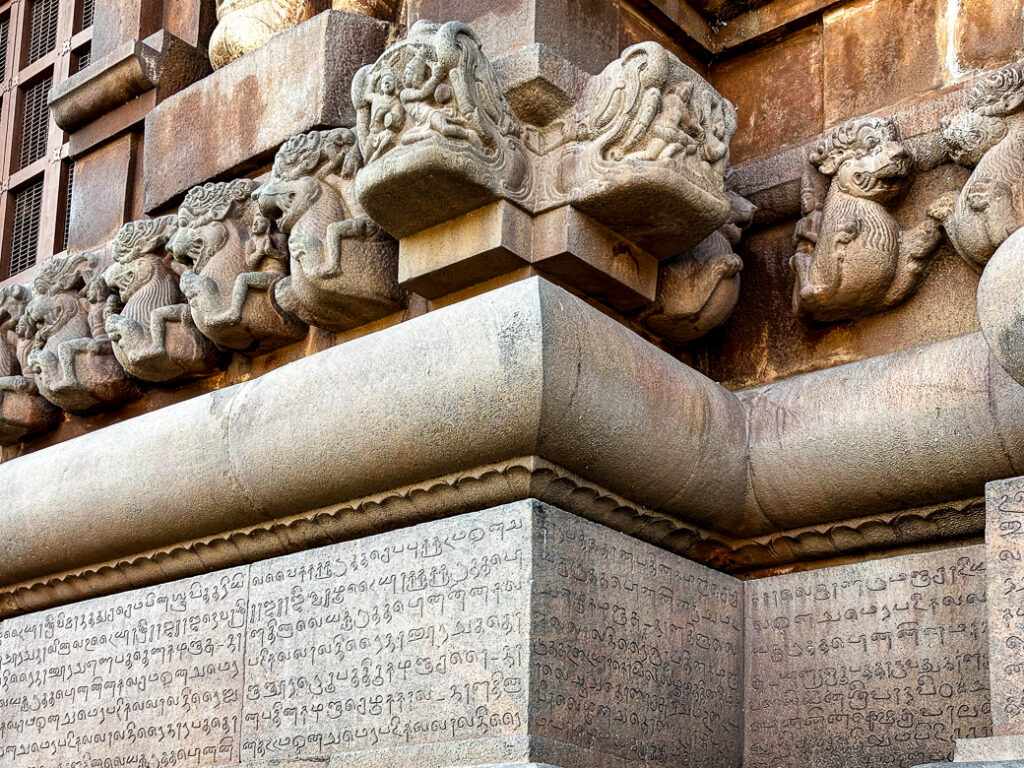
The inscriptions mostly describe the achievements of Rajaraja I and his generous and skilful endowments meant for the upkeep of this massive temple.
Paintings:
One of the most fascinating features of Brihadisvara Temple is the abundance of wall murals dating back to the times of the Cholas. The paintings are of exceptional quality and art experts put them in the same bracket as the more famous Ajanta Cave paintings.
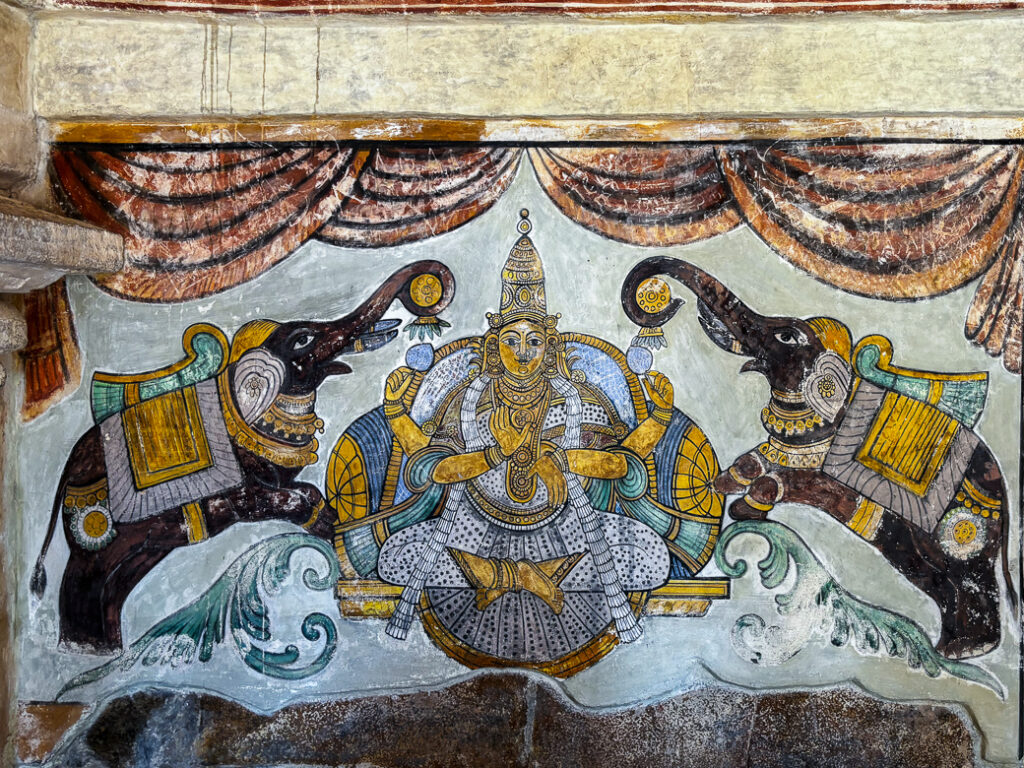
The dark passage surrounding the temple’s sanctum contains striking specimens of paintings. The western wall is adorned with a huge panel of Siva as Dakshina Murti, seated in a yogic pose. A little further, you can see a Nataraja temple as well as a large figure of Nataraja dancing in the golden hall at Chidambaram. Nearby, Rajaraja himself is painted along with his guru, Karuvar Devar. The entire northern wall is covered by a gigantic figure of Tripurantaka Siva on a chariot driven by Brahma, which is regarded as a masterpiece of Chola painting.
More vibrant paintings belonging to the Nayaka era are found on the inner walls of the cloister mandapa that surrounds the temple. The subjects of these paintings, found on the northern and western walls, include Gaja Lakshmi, Uma–Mahesvara, Sarasvati, Mahisasuramardini, self-immolation of Sati, royal processions, and so on.
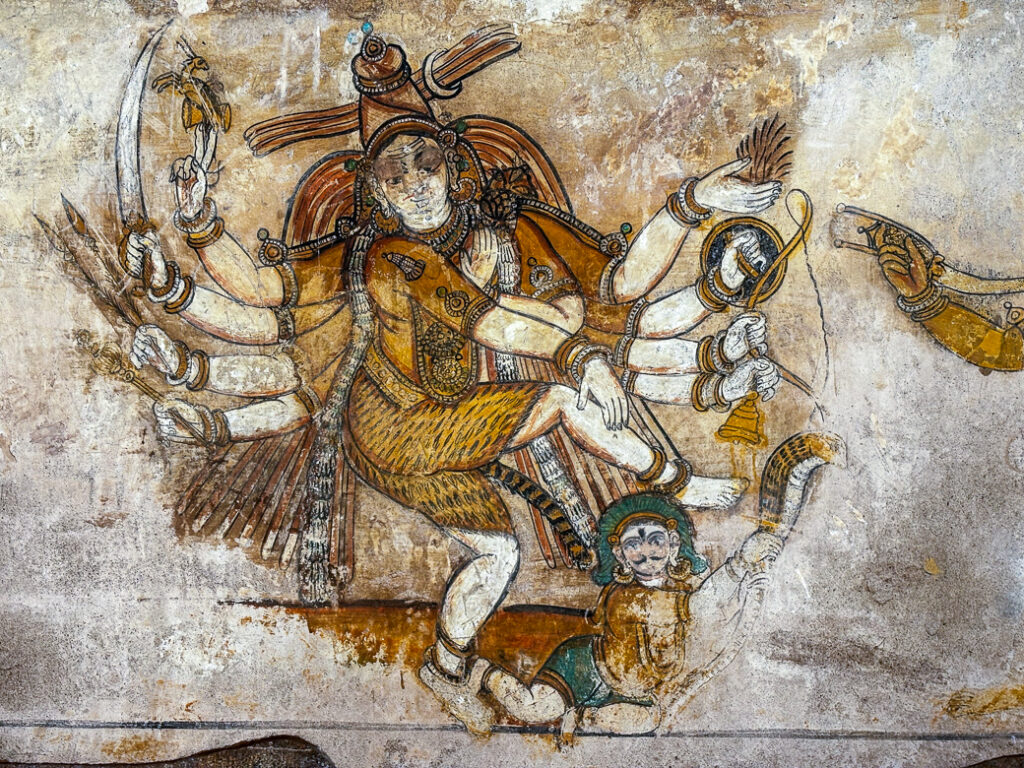
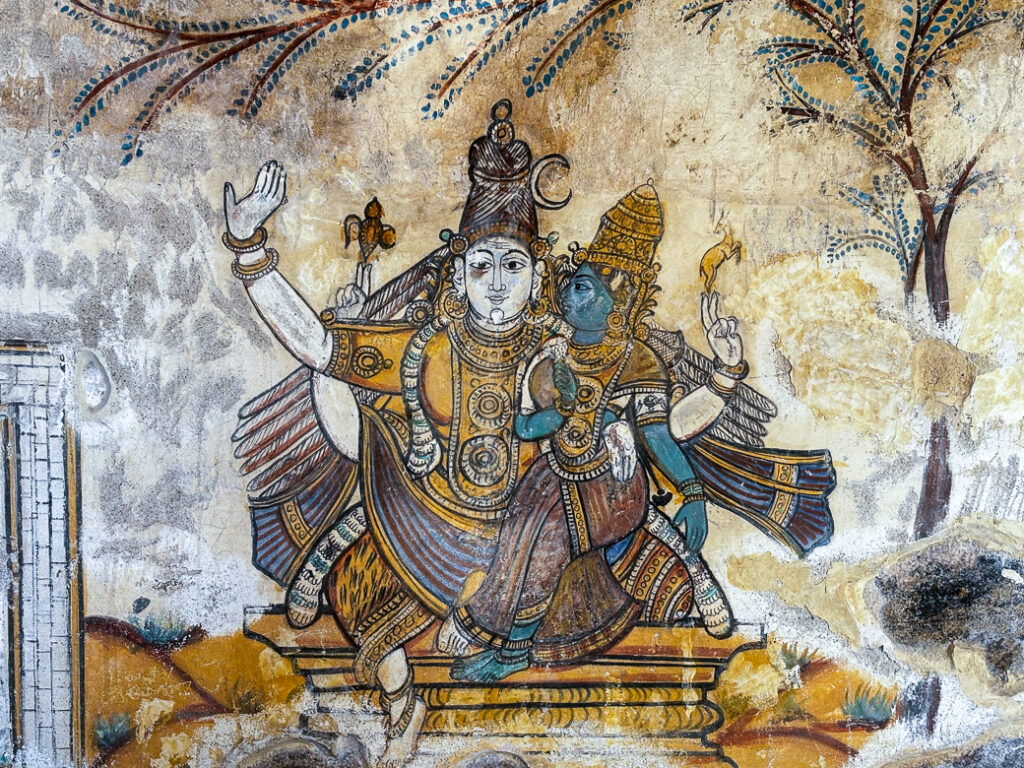
Additional shrines inside the temple complex:
The Brihadisvara Temple complex hosts a number of smaller shrines.
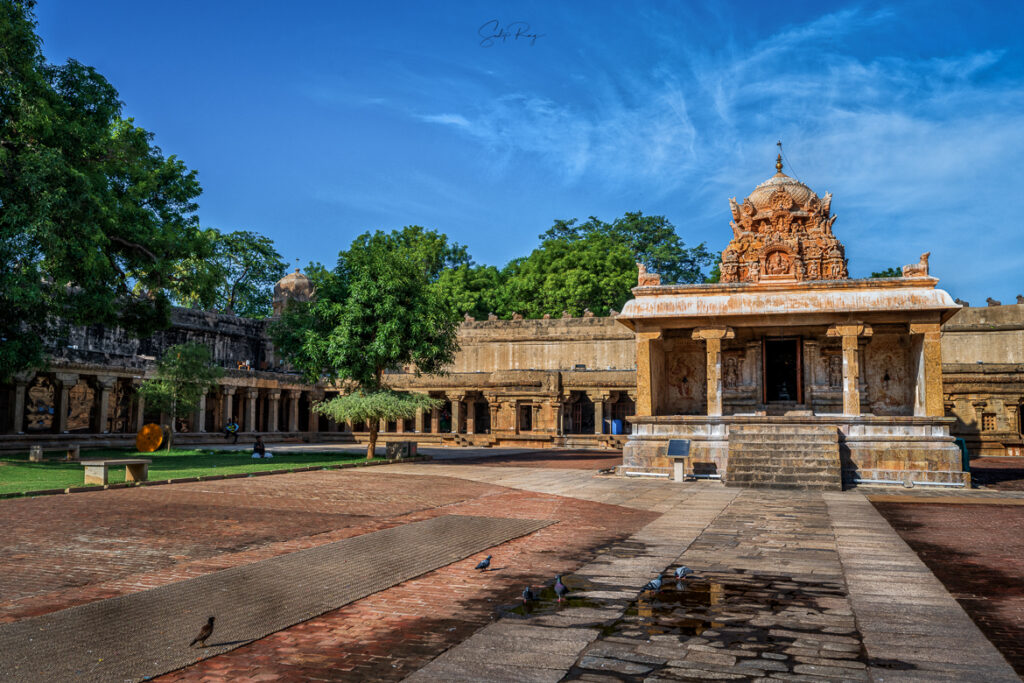
Shrines are dedicated to Siva’s consort Parvati, his sons Subhramanyam (built by the Nayakas) and Ganesa (constructed by the Marathas), Varahi (quite popular among the local residents), Rajaraja’s guru Karuvar Devar, Chandesvara, and Nataraja.
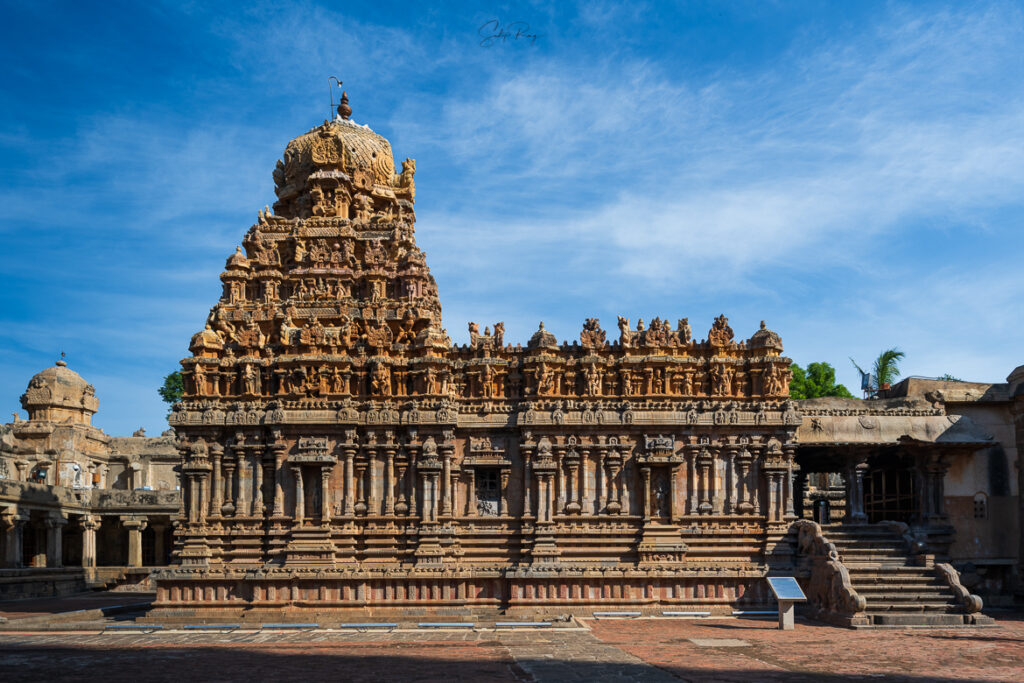
Important FAQs:
Where is the Brihadisvara Temple situated?
The Brihadisvara Temple is located in Thanjavur, Tamil Nadu. Thanjavur is 344 km away from Chennai, 185 km from Madurai and 57 km from Tiruchirappalli.
How can I reach the Brihadisvara Temple?
By air: Thanjavur’s nearest airport is Tiruchirappalli. Though frequent flights to Tiruchirappalli from most of the major south Indian cities are available, connectivity from other parts of India may be an issue. Hence it would be wise to fly into Chennai, which is very well-connected with every part of India.
By train: Chennai is also well linked by railways with the rest of India. From Howrah, you can board 12839 Chennai Mail, from Shalimar 12841 Coromandal Express, from New Delhi 12622 Tamilnadu Express and 12616 Grand Trunk Express, from Mumbai 22179 Chennai Express, and from Bengaluru 12028 Shatabdi Express and 20608 Vande Bharat Express.
From Chennai, you can easily reach Thanjavur by train, such as 22675 Chozhan Express and 16865 Uzhavan Express.
By bus: Daily TNSTC buses from Chennai, Tambaram, and Tiruchirappalli ply to Thanjavur.
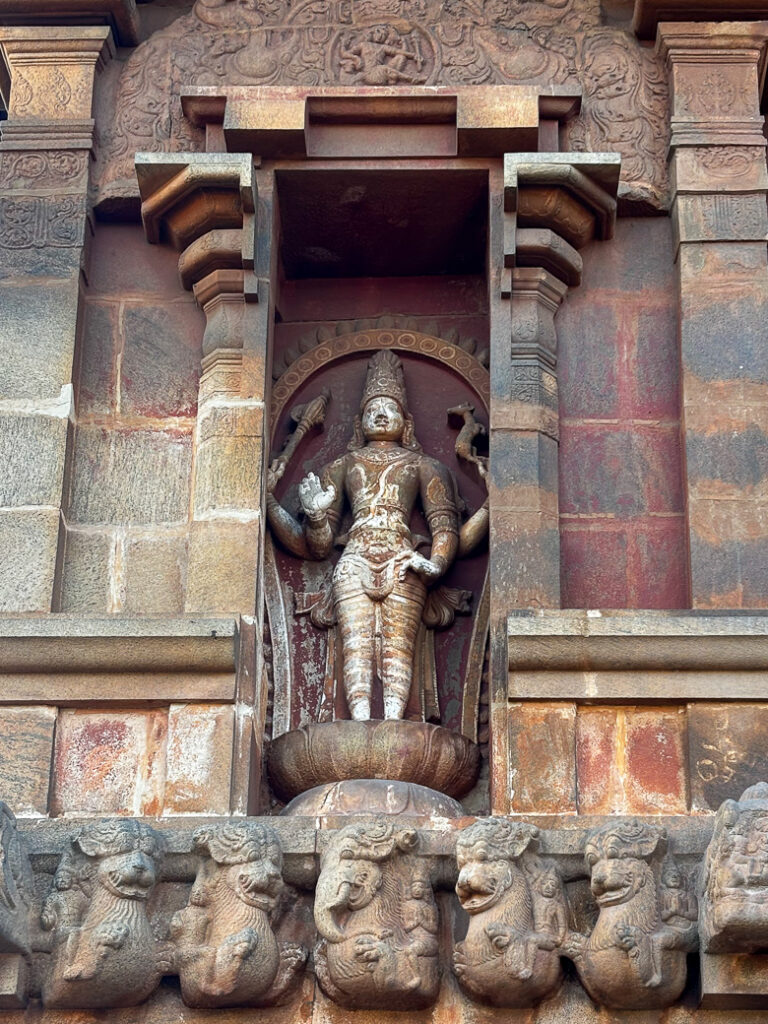
Is there any entry fee for the Brihadisvara Temple?
No entry fee is required to visit these temples.
What are the timings of the Big Temple of Thanjavur?
Like every other temple in Tamil Nadu, it remains open from 6 AM to 12 PM and again from 4 PM to 8 PM. We found that like other monuments maintained by the Archaeological Survey of India, this temple do not remain open from 6 AM to 6 PM.
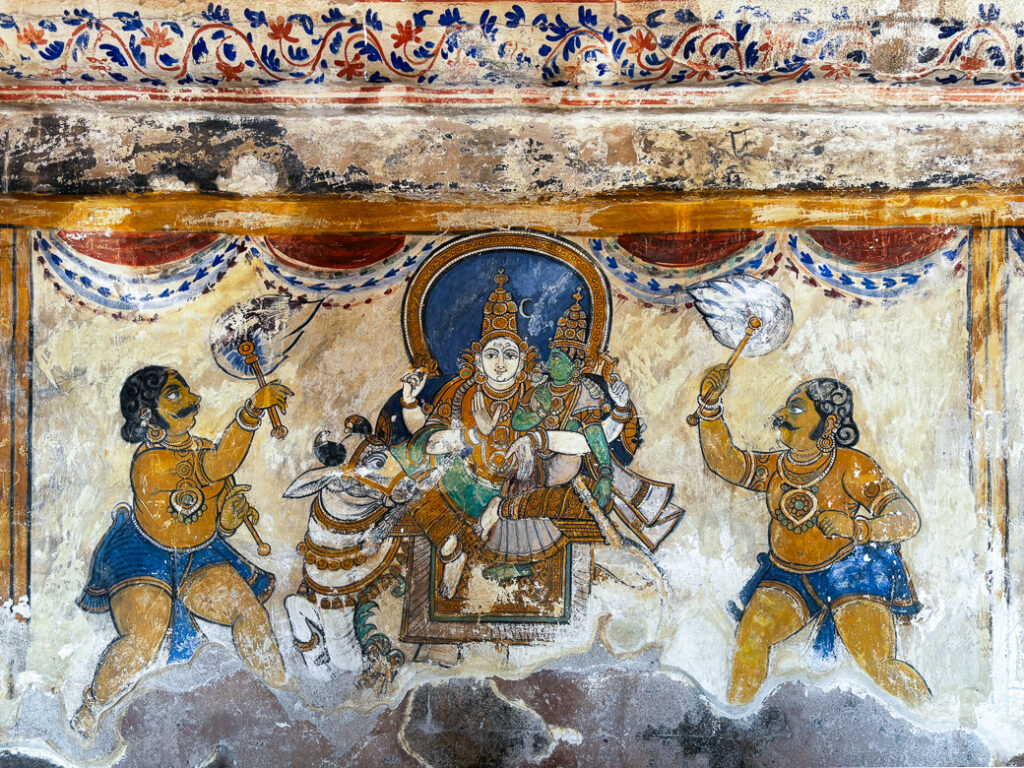
What is the best time to visit this temple?
Although Tamil Nadu remains more or less hot and humid around the year, October to February is comparatively cooler. Also, try visiting the temple early in the morning. Temperature soars as the day proceeds making it uncomfortable to explore the temples.
Where can I stay in Thanjavur?
We stayed in Svatma, which is a heritage property. You can also look for Sangam Hotel and Hotel Gnanam.
Where to eat in Thanjavur?
Thanjavur has some interesting and nice restaurants where you can try Tamil cuisine such as Thillana, Vasantha Bhavan, and Pattukottai Kamatchi Mess.
